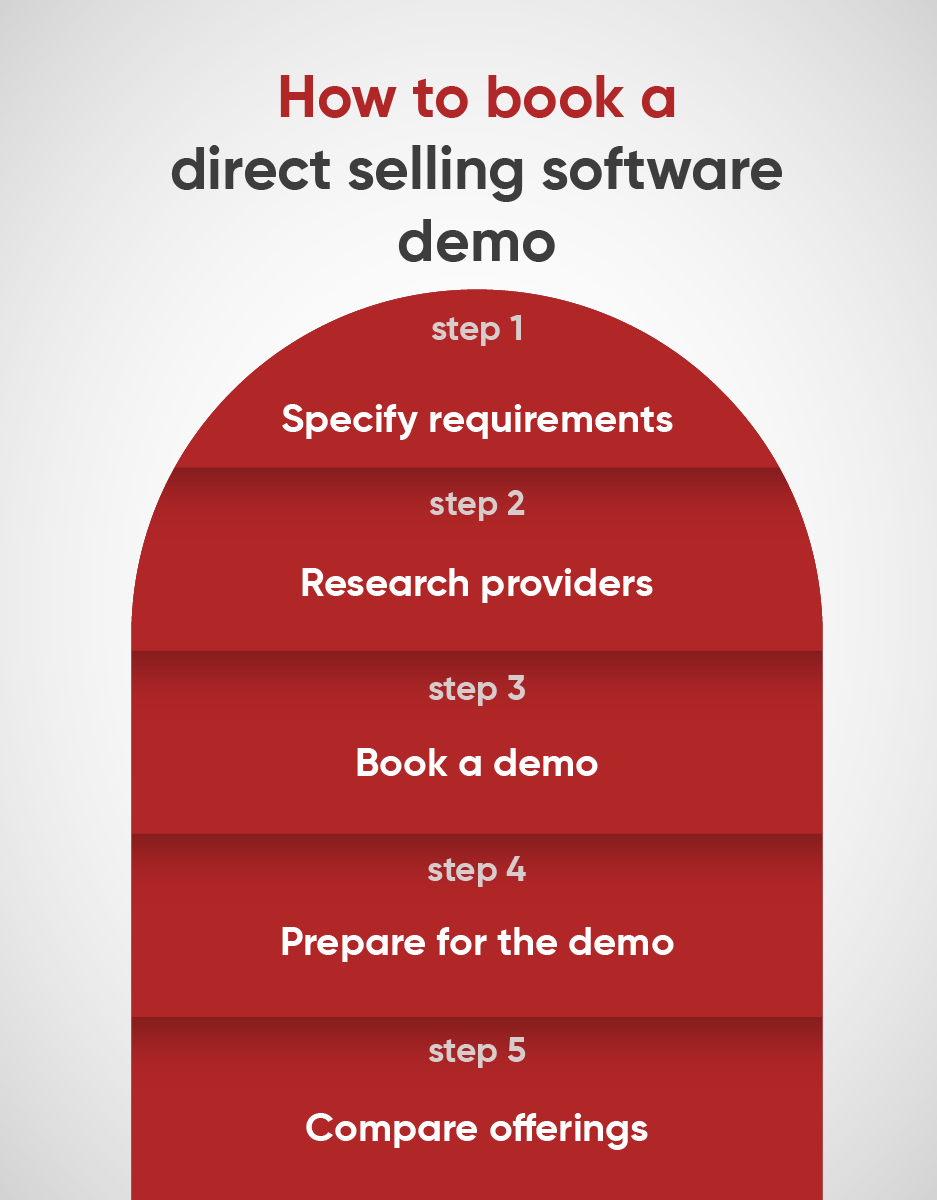How to book a free direct selling software demo as a new entrepreneur

Having the proper software can significantly streamline your direct selling business through inventory management, order processing, commission management, and advising sales personnel. Free demo is the best way to test the platform's features to avoid any financial risk before payment.
In this guide, we’ll look at:
Clarifying your software needs
Shortlisting potential vendors
Booking a free demo
Getting ready for the demo
Assess your requirements
Helpful tips for new direct selling entrepreneurs

1. Specify your direct selling software requirements
Before contacting a vendor, dedicate some time to outlining what you need specifically in your business:
Rep onboarding
Do you need automatic sign-up forms or an e-learning module for your new reps?
Inventory and order management
Is real-time tracking or subscription (autoship) ordering of the utmost importance?
Commission and bonus structure
Flat fee, overrides, and other special performance commissions?
Customer database and CRM
Built-in marketing tools, reminders for follow up with clients, or a unique shopping experience for each client?
Scalability
Do you want to reach regionally, nationally, or internationally? Check for multi-language or multi-currency capabilities.
Discover effortless order processing and customer relationship management with our MLM software
Start Free Trial2. Research and shortlist potential vendors
Armed with your feature list, you can start searching for direct selling software vendors that align with your requirements:
Online search
Make use of the right keywords like free direct selling demo software, home business direct selling software, or party plan demo software.
Reviews and testimonials
Look out for third-party review sites, or social media group forums or websites for direct sellers to get real-time user feedback, comments on ease of use, level of support they receive, what they pay and their overall experience.
Feature pages
Check out their websites to ensure they support the key features—you know, automated commission management, inventory tracking, or multi-level overrides if you need those.
Support and training
Be sure they have good onboarding materials, tutorials, FAQs, or a user community. Good support is priceless once you get rolling.
After you’ve explored a few candidates, narrow your list down to two to four vendors that seem the most promising and offer a free trial or demo.
Discover how we build resilient businesses with advanced MLM functionalities
3. Book a free demo
After you've shortlisted your favourites, it's time to schedule the demos:
Website demo request
It is very common to see a button that says "Book a Demo", "Free Demo", or "Schedule a Call”. Complete their template with your personal phone number, business information, and desired time windows. Describe your objectives (e.g., "stable order management together with a multi-tier commission model").
Contact form or email
If the vendor does not have a specific demo URL, use their general contact page or email address. Let them know you’re a new direct selling entrepreneur and you’d like to have a free demo to see if their platform is a good fit.
Phone or live chat
Some vendors provide real-time chat or a phone line. They are a potentially convenient mechanism to set up a demo on the fly and utilize the opportunities to convey your major requirements in parallel.
What to ask for?
Customized demo: Ask for a demo based on your top priorities; for example, inventory control, commission calculations, compliance management or distributor training.
Live Q&A: Check if they are able to answer your real-time questions regarding pricing, setup or customization that you may have.
Understand how to equip your sales personnel with the best tools for success.
Book a Demo4. Get ready for the demo
To get the most out of your demo:
Review your must-have list
Write down detailed questions regarding commissions, user limits, payment gateways, or customer databases.
Sketch your workflow
Now create a simple diagram to show the flow of orders from the customer to the rep and into the company. You can then share this with the vendor so they can shape their demo based on your live process.
Check your tech
Test your internet, audio, and, if recording, your screen recording application to ensure everything runs smoothly.
Involve any members of the team or mentors who may provide more inputs.
Demo
Look at the user interface: Is it intuitive for you, and for reps who are not as tech-smart?
Ask for real scenarios: Ask them to demonstrate step-by-step on how to enroll a new rep, place an order, apply a discount, and later track and update commissions in real-time.
5. Compare your choices
After each demo, consider the following:
Compare features
Was the system demonstrating the functionality you needed, say multi-level commissions or complex reporting? Did it look simple or complicated?
Pricing and contract terms
Do they charge you a setup fee, monthly payments, or even transaction fees? If you are on a very tight budget, do they have scaled-down packages or flexible payment plans?
Reflect on support and training
Was the speaker knowledgeable? Did they give you and your representatives some useful resources? Great support can be all the difference when you are new to an activity.
If the vendor checks most of the boxes on your list and you feel comfortable during the demo, schedule a follow-up or a free trial if available. Otherwise, go through your shortlist or continue searching to find the right one.
Booking a free direct selling software demo is an important part of the right decision-making process in terms of which platform should power your business. By simply defining your needs, short-listing suitable vendors, asking focused questions, and paying attention to user-friendliness and support, you'll be better prepared to make a decision that sets you up for long-term success.
Remember, the right demo will walk you through exactly how the software handles your everyday processes, from enrolling new reps and managing orders to calculating commissions and retaining customers. With the right tools in place, you can focus on building relationships, nurturing your team, and driving sustainable growth in your direct selling business.



